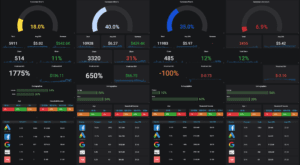Marketing attribution is hard. Correctly tracking your attribution can determine the ROI on your campaigns and can help you optimize your marketing performance.
I was working with a company who used a third-party agency to manage their advertising. The company was spending thousands of dollars per week but weren't getting conversions. AND, the data the marketing agency was reporting was dramatically different from reality.
The Findings
Here's what I learned by analyzing their customer data directly:
Cost Per Lead Reported: $1 Actual: $5
Cost Per Acquisition Reported: $7, Actual $19
Abandonment: If users came in from Google Play, they had a 23% higher abandonment rates compared to the App Store.
Demographics: Users who lived in zip codes averaging over $60k per year had a 50% higher likelihood to convert from a free trial.
Activity: If users took one specific action in the app, they had an 85% higher probability of conversion.
To be clear, marketers have an unfair problem. It's hard to track a person across the internet. The tools to support this have a massive undertaking to get right, and creatives aren't usually good at data analytics. Being creative and analyzing data are two very different skillsets.
Ultimately, the reasons for this were complicated. There were multiple failure points in the process stemming from problems with tool implementations, human process failures, data sources, and data availability.
Issue #1: Double and Triple Counting
This agency provided source code for Google Analytics and Google Tag Manager. The first learning was that it's challenging to implement these solutions correctly. We had two attempts from two different teams: the first was an offshore team that wasn't amazing, the second was an onshore guy who was amazing.
Google Tag Manager counts a conversion when the code is displayed on the screen. It doesn't filter out unique vs. non-unique values. The marketing agency was celebrating because of how many leads they were converting from ads. The marketing metrics were between 2-3x higher than the real number of customers who converted.
The cause of the problem was a coding error. Multiple sections of the app used this page, and every time this page was seen by a customer, it counted as a conversion.
A second issue occurred here. The company had dozens of fake accounts created each day. The marketing costs were skewed because a lot of ‘leads' were generated for bogus accounts.
Multiple code updates were required to make sure the tag was only displayed the first time someone hit the page. This took numerous attempts for the development team to get right. Even after the code was fixed, the actual customer numbers never matched the Tag Manager conversions. The metrics were deemed ‘close enough' to use for marketing reporting.
Issue #2 - Calculating Costs and Revenue
Then the next issue arises – how to estimate costs and revenue.
The marketing agency did what most agencies do – they estimated the revenue for the lead, and they estimated a target cost per acquisition.
The problem was with their calculations. The agency estimated a 100% conversion rate after a free trial. The cost per acquisition also didn't match the ad campaign costs.
Long story short – because the churn rate was averaging between 50-85% per day, the revenue should have reflected a number significantly smaller. The Cost Per Acquisition numbers should have been 2-3x the amount the agency was reporting.
Issue #3 - Cross-Platform Advertising
In many cases, companies use more than one advertising channel. This company was no exception. They had four different ways that an ad might hit the customer (not to mention retargeting ads.)
While Google Ads was accurate about calculating its own costs, the metrics didn't include the charges from the Facebook Ad platform.
Again, the CPCA was lower than the real number because the Facebook Ad costs weren't included. It made it look like the CPA was great when it was TERRIBLE.
Now, that said, there are ways to ad Facebook ad data into Google. Because it took over 100 hours of development work just to set up the Google Ads tracking, there wasn't much inclination to add the code needed to send Google the data from Facebook.
The agency solved this by creating a manual spreadsheet that combined the data from Google and Facebook, calculated leads from Google, and manually re-calculated the CPA in their spreadsheet formula.
Issue #4 - Lead Source Tracking Problems
This company had a website, a web application that the customer's use for registration, and an app in the Google Play and App Store.
The ugliness is that it is HARD to guarantee that leads are tracked correctly across different systems. (If you search the web for ‘cross-domain lead tracking,' you'll find a SLEW of unhelpful and highly technical information about why this can't be done accurately.)
Most companies add UTM codes into the URL to track the source of the lead.
Four different problems happen here:
Problem 1: The actual lead source can change. For example, you create a Facebook ad, and the URL gets shared on Twitter. The UTM code would show that the lead source is the ad, but the lead source is Twitter.
Problem 2: The tracking can get broken along the way. For example, every “Sign Up” link had to include the UTM codes in the Sign Up URL.
I had to add code to the website that added a cookie to track the lead source — then added code to the server that looked at the cookie and modified the URL to include the UTM codes.
Problem 3: The marketing agency can create whatever links they wanted. If they didn't communicate the process, then my code wasn't used, and the lead wasn't tracked.
I was asked to research an issue with the tracking – it wasn't working (again). Regularly, I would find the URLs were hard-coded links, not using the code I created for tracking the links.
This was a process/people problem, not a technology problem.
Problem 4: The code I wrote was in WordPress, and as a result, that code could change. I customized a free plugin to log the cookie. The company that hosted the website was kind enough to update all of the plugins.
Boom – all my code was gone. It took about a week for the business to notice that there were a disproportionate number of ‘organic' leads from average.
From there, I had to trace back every step in the process to figure out why it wasn't working.
Issue #5 - App Downloads vs. Conversions
If you have an app in the app store, trying to track advertising and conversions on both Google Play and the App Store is painful. In these stores, it's easy to see metrics such as in-app billing, downloads, and uninstalls. Tracking a download to an actual customer is another thing.
Third-party companies track using a combination of device information (OS and browser), date and time information, and cookies. Then they triangulate and de-dupe this data across multiple companies with the hopes of linking to a specific person.
Long story short – it's a ridiculously complicated process that requires significant development talent to make it work.
If you don't have $20-40k for app development and update costs for this and $5-10k per year to maintain it, this option isn't available for you.
Issue #6: Incognito Mode & Anonymous Browsing
People are getting smarter about privacy. I switched from Google as my primary search engine over to Duck Duck Go, the browser that doesn't follow and retarget you. They are very privacy-focused.
With incognito mode, you lose access to cookies set by your previous sessions. So when someone uses incognito mode, they are new to you, even if they visit your site every day.
Also, new Chrome Plugins are available that block ad tracking extensions. I use one called ‘Ghostery' that blocks Google Analytics, Facebook/Bing Ad tracking, and every other tracking extension they find.
If their code is blocked, it's not attributing correctly.
Issue #7: Tracking PR, News, and Influencers
With ads, you control the URL, and you control the UTM codes. With PR, News, and Influencer sources, you can't control this – at all.
I've seen major news outlets (major) have incorrect links to the company that is the subject of the story. It's even worse for bloggers. They can create great content but don't necessarily have an eye for details. I've seen between 10-15% of affiliate links contain a misspelling. These misspellings go straight to a 404 page on your website (Not Found) if they aren't fixed.
Without a database of company events and timelines, it's impossible to track spikes in website traffic and if the effort to create the PR or relationship was worth it. It's easy to correlate and report on the information when you have a flexible system to store it in.
The un-named company did a great job of getting news coverage in a major metropolitan city. They had thousands of signups in the course of a week after the coverage, more than they had the previous six months.
But then analyzing the data after-the-fact, I found that those customers had higher-than-average cancellations and higher-than-average bounce rates when attempting payment for the membership. Ultimately this company got great marketing in an area that wasn't their target market.
Issue #8: Click fraud and Bad Keyword Matching
Did you know that other companies can quickly drive up your advertising costs? Did you know that advertising companies don't do much to stop it? They have some controls when they see repeated traffic from the same IP, but it's easy enough to switch IPs and run up your bill.
A second problem is around how companies like Google match keywords. I've had my own experiences where I've created campaigns only to have keyword matching problems.
I created an ad for “Robotic Process Automation” with disastrous results. Hundreds of dollars wasted without a single lead.
Even though I quoted the keywords – only match on those three words together – the matching algorithm lumped in “robots,” “robot manufacturing,” and other unrelated keywords.
If you've ever noticed that a large number of paid ads go to your home page and immediately bounce, you are the victim of one of these two problems. If you notice the same traffic from the same IP, it's most likely click-fraud.
How to Fix Your Marketing Attribution
We use a combination of data sources in order to accurately calculate marketing attribution.
Data Source #1: CRM system
Your CRM has the truth on what revenue comes from your customers. If the payment doesn't occur and isn't registered here, it didn't happen. Your CRM should be the #1 source of truth for your customers and your relationship with them. It's crucial that it's populated and is updated.
Data Source #2: Website Logs
Most people don't know that when you visit a website, the server tracks the IP address, device, and URL accessed. They can't be blocked and live on your server, which means that ad-blocking and privacy plugins aren't effective. You can see the traffic patterns from anonymous users and when integrated with your customer data, you can de-anonymize the traffic to see what customers viewed what content before making their buying decision.
In these website logs is a LOT of junk, but you can clearly see referrers, UTM codes, and identify bounce rates of ads. This can also be a great source for detecting click fraud, as the fraud often comes from the same IP address which can be blocked.
Data Source #3: Google Analytics and Webmaster Tools
This is the best source of information for which SEO keywords are working and which are not. Combining this data with the log information, you can see the keyword someone came in on, the behavior of the customer and the call-to-action that converted.
Data Source #4: Ad Platform APIs
We like to pull in all of the ad platform data into a single repository. It makes it easy to see which campaigns and ads are working and which ones are a waste of money. It also helps you see which keywords aren't converting when integrated with the website logs.
Data Source #5: Cookies
We push traffic history into our own database. We do it from the server so it's not blocked by ad-blocking scripts. We leverage this information to determine traffic history and will eventually use this to create personalization on our website.
Next Steps
If you are serious about improving your marketing ROI and identifying the true source of your campaigns, we can perform a free assessment and share with you best practices that can help improve your marketing analytics and attribution. Schedule a time here: https://askatlas.ai/demo








